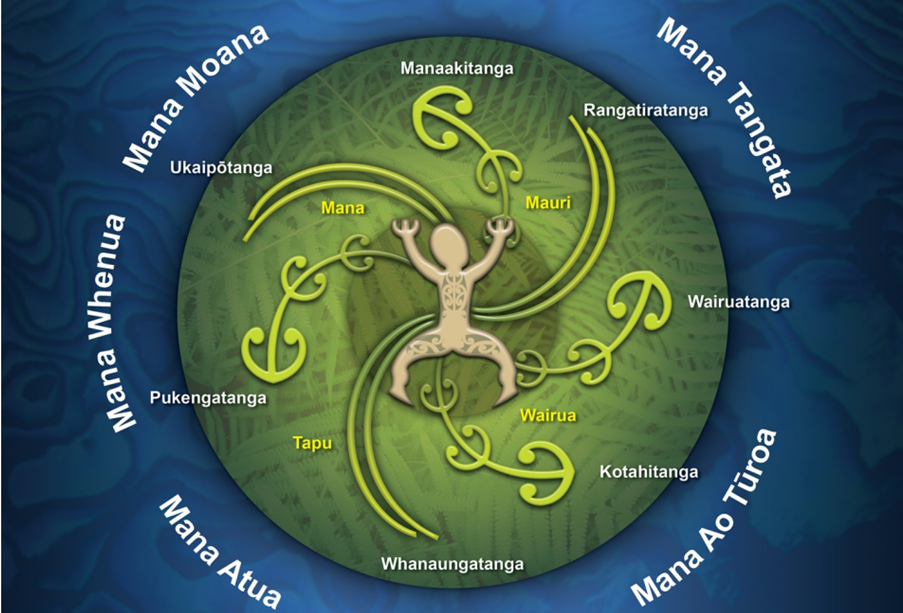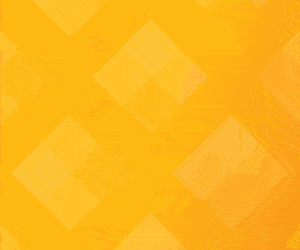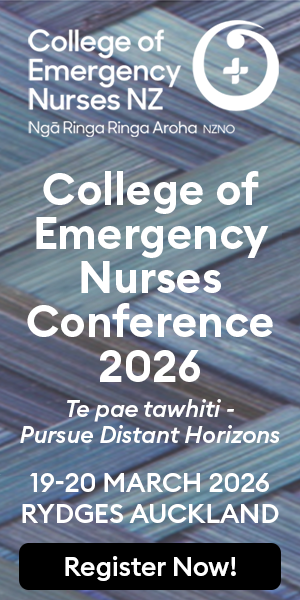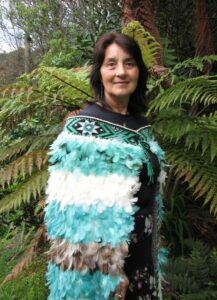
Ngā mihi mahana kia koutou katoa.
Ko wai au?
Ko Mataatua te waka, ko Matiti te maunga, ko Waioweka me Otara ngā awa, Ngati Ira me Ngāi Tamahaua ma ngā hapū, ko Whakatohea te iwi, no Opotiki te kainga tuturu.
Ko Hemaima Hughes ahau.
Ko au he Tapuhi me Kaiako ma mo te Ōhanga Mataora Paetahi: Bachelor of Health Sciences Māori (Nursing) ki te Whare Wānanga o Awanuiārangi.
No reira, tēnā koutou, tēnā koutou, tēnā koutou katoa.
Tangata Raukotahi
Nau mai, haere mai ki te hīkoi o Tangata Raukotahi enshrined, sustained and intrinsically linked to our mana atua, mana whenua, mana moana, mana tangata and mana ao Tūroa. We will explore the significance and application of Tangata Raukotahi in the context of nursing practice. Tangata Raukotahi is a concept that holds deep meaning, as beautifully articulated by Jay Rerekura in 2022: “Haramai, haere atu koe i to Raukotahi – kei muri i a koe, kei mua ai koe, kei o taha to Rarangi Matua.”
According to Rerekura (2022), Raukotahi emphasises that we are not solitary individuals but a culmination of all those who came before us, those who stand with us, and those who will follow in our footsteps.

Jay’s poignant words during his farewell to his father, shed light on the essence of Raukotahi: “This concept of Raukotahi embodies the belief that we are the collective fruition of our ancestral heritage and the meaningful influences of those who contribute to our lives today. It also underscores our duty in shaping the well-being and aspirations of future generations”. To know that we have everything that we need in our DNA to guide us is very refreshing.”
Between the years of 2006 -2008, Tauni Scott introduced a kaupapa Māori framework that seeks to integrate the principles of Tangata Raukotahi into nursing practice. Prior to his presentation to the accreditation panel, Tauni had presented and discussed his moemoea of Tangata Raukotahi as a conceptual model that would succinctly fit with the envisaged work of a Māori nurse with his/her patients with our Te Kaunihera o Ngā Māori o Aotearoa curriculum development working group.
Jenny Kaka-Scott, te hoa wahine of Tauni (personal communication, April 1 2023), it is our understanding that the concepts/kaupapa of manaakitanga, ūkaipōtanga, pūkengatanga, whanaungatanga, kotahitanga, wairuatanga and rangatiratanga were proposed by Whatarangi Winiata supported by Ta Mason Durie ki Te Whare Wānanga o Raukawa. We also acknowledge that major contributions to the process were made by Tamati Kruger (Tuhoe), Danny Poihipi (Te Whānau a Apanui) and Rikirangi Gage (Te Whānau a Apanui me Te Whakatohea).
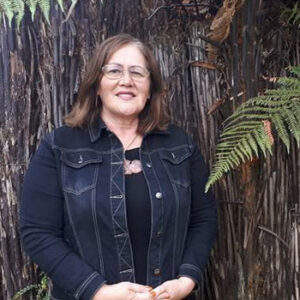
Regarding the Tangata Raukotahi graphic model representation, it is my understanding that the model itself was possibly designed by the Curtis brothers who have a graphics business in Rotorua.
The framework ensures that clinical practices, policies, procedures, arrangements, delegations, and planning associated with clinical placements with a set of agreed-upon kaupapa Māori principles.
At its heart, lays the fundamental belief that the tangata remains at the core of their practice.
This Māori perspective, grounded in Tangata Raukotahi, provides a holistic framework for nursing, it places a strong emphasis on cultural competence, respect, and the overall well-being of individuals and communities. Through this cultural lens, we are dedicated to fortifying our commitment to nursing practice, with the ultimate goal of enhancing the lives of all those under our care.
At the centre of the model is te tangata, representing both the nurse and the patient/tangata whaiora/turoro integral to the reciprocity of caring. Because just as the nurse/carer intrinsically possesses and holds to each of the values identified with in the model as integral to their connection and wellbeing, so too are these values held by the patients that are being cared for.
This belief is enveloped by seven essential kaupapa Māori principles of wairuratanga, ūkaipōtanga, rangatiratanga, manaakitanga, pūkengatanga, rangatiratanga and kotahitanga. These principles provide the foundation for our practice and are elaborated upon as follows:
Tuatahi: Wairuatanga
The concept of wairua is essential in Māori-dom, it is a two way process as it is believed to be a vital part of a person’s identity and well-being, going beyond their physical existence. It is associated with feelings, emotions, and intuition, and plays a significant role in traditional Māori healing and spirituality.
Tapu represents sacredness or restriction, much like an urupa, a sacred burial ground. On the other hand, noa signifies the opposite, signifying things that are non-restricted and blessed. Everyday elements such as water and kai are made noa through blessings.
Speaking for myself, my spiritual connection revolves around connecting with the realm of spirit, which I believe comes naturally to many Māori. It involves feeling emotions (unintentionally) and unexplained sensations, perceiving beyond physicality to understand a person’s wairua or spirit.
This understanding also extends to recognising that sometimes modern medicine isn’t the only option to healing. Healing can also look like the rā (sun), rongoa (Māori traditional medicine) and aroha (love) that all contribute to the well-being of the wairua (spirit).
The concept of wairuatanga rises above boundaries, emphasising the spiritual connection that goes beyond the physical. It encompasses the balance of tapu and noa in our lives, ensuring that our spiritual well-being remains in harmony with our cultural heritage.
A clinical scenario of applying wairuatanga in practice may include the following:
- Acknowledging tapu: discussing end-of-life care or culturally sensitive issues that may require a respectful and sensitive approach.
- Creating a noa environment: karakia before the day begins with colleagues, ensuring the space/environment is noa and welcoming.
- Spiritual connection: Understanding that wairuatanga extends beyond physical symptoms and involves addressing the patient’s spiritual well-being.
- Holistic healing: discussing the benefits of sunlight, connecting with the land, a good old feed whether it be mahi kai or a balanced diet, the support of both whānau and friends, healing clinics that involve mirimiri, romiromi, traditional rongoa treatments complimentary to medical care, and my favorite a mean horoi in the Moana to help cleanse all that hara away.
By combining these elements into the clinical setting/environment, a healthcare provider not only respects the patient’s cultural beliefs but also provides a holistic approach to healing that addresses the patient’s spiritual and physical well-being.
Wairuatanga being integral to cultural wellbeing is recognising and perpetuating the balance of tapu and noa and supporting the institution of tohunga to grow spiritual commitment and activity via the poutama as follows:
- Supporting a patient’s beliefs and culture which is integral to individual and cultural wellbeing.
- Utilizing wairuatanga to guide clinical practice.
- i.e. Te hāhi…. all hāhi as a beacon to ensure our moral compass.
- How we recognise one’s spiritual and cultural practice and how you support it in care.
- Accessing cultural resources and tohunga to inform clinical decision making between tapu and noa, hara and tika for both patient whānau and healthcare team.
Tuarua: Ūkaipōtanga
Is all about deep connection we have with our personal and collective identities, our ancestral heritage, and the land we call home. It’s like a reminder of the power of understanding our whakapapa, like our family tree, shapes who we are individually and ties us to a larger community and the natural world.
When it comes to healthcare, Ūkaipōtanga guides us in recognising and respecting the cultural roots of not only our Māori patients, but for all. When we’re interacting with a Māori patient, naturally it’s all about something as little as taking that one moment to introduce ourselves in te reo – Kia ōra whaea/matua, and sharing a bit about the rivers, mountains, tribes, and sub-tribes we’re connected to. This simple act acknowledges the patient’s cultural identity and makes their care feel grounded in their ancestral land. But it’s more than just the surface level of care. Ūkaipotanga challenges us as nurses to make sure our patients really understand their health, their right’s, and their role in managing their well-being. It’s about empowering them to make informed choices and decisions about their healthcare, which is super important in providing holistic and culturally competent care.
Therefore, ūkaipōtanga is not just a concept,’ it’s a whole approach to healthcare because it recognises how cultural identity and heritage play a major role in healing. It’s about creating an environment where patients, no matter where they are from, can draw strength from their roots, upbringing, and shared experiences with neehi Māori to be able to obtain the best health outcomes. And it is all about fostering connection and unity in healthcare, where everyone’s unique journey is respected and valued.
Applying the following steps below ūkaipotanga therefore is about recognising whakapapa as the source of individual and collective esteem and developing a sense of belonging to people and land.
2.1 Utilising ūkaipōtanga to guide clinical practice.
2.2 Recognising whakapapa and whenua as the source of individual and collective self-esteem
2.3 Knowledge of self to serve others
Tuatoru: Rangatiratanga
According to kura po tauira or second year nursing students at Te Whare Wānanga o Awanuiārangi, Shannyn Bristowe and Bryalee Marshall (2023), rangatiratanga is a stance of self-determination for tangata whenua, that encompasses recognising and perpetuating roles within the whānau and developing a strong political voice, concluding in mana whenua, guardianship, and protection over tangata whenua institutions.
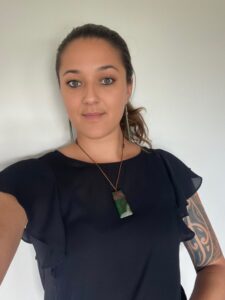
For tauira to work effectively with Māori and to demonstrate Raukotahi in the hauora setting, they must possess an understanding of te reo me ona tikanga. Tauira of this program will be equipped to deliver quality health services to both Māori and other citizens of Aotearoa and meet the cultural and nursing requirements of both hauora Māori providers and non-Māori health service providers. My classmates and I will go forth demonstrating Raukotahi principles within our practice to uplift, support, and empower our community to provide the best possible care we can and to inspire future generations.
Rangatiratanga therefore is a stance of self-determination for tangata whenua, encompassing recognising and perpetuating positive roles within whānau, hapū and iwi encompassing the following:
3.1 A stance of self-determination in terms of decision making for one’s own health inclusive of the nurse’s leadership and management approach.
3.2 Developing a strong awareness and voice in advocating and protecting whānau, hapū and iwi.
3.3 Participate in quality improvement strategies to influence change.
Tuawha: Manaakitanga
Manaakitanga, according to kura po tauira Bryalee Bristowe (2023), is the cornerstone of nursing practice, embodying the essence of caring and compassion. It goes beyond mere medical care; it is a profound commitment to supporting, guiding, and uplifting those we serve.

In nursing, manaakitanga means ensuring that every interaction is infused with ngākau māhaki, and aroha. It’s about advocating tirelessly for our patients, whether they are tūroro or members of the wider hāpori.
Manaakitanga calls us to recognise and respect the unique mana, inherent worth, and dignity of everyone. It means providing not just medical treatment but also the resources and knowledge necessary for patients to understand and manage their conditions. It’s helping them prepare for the simple acts of daily living; it’s education, empowerment and promoting their overall well-being.
Above all, manaakitanga is about treating every patient as if they were a beloved member of our own whānau. It’s the simple acts of kindness, like sitting down to talk, offering a warm blanket, or a comforting cup of tea. Manaakitanga isn’t just a concept; it’s a way of life, it is the thread that weaves together the tapestry of holistic healthcare, ensuring that everyone not only receives treatment but also experiences the warmth of human connection, it is an unwavering commitment to providing the best care possible, guided by the values of love, respect, and compassion. It’s a commitment to the holistic well-being of everyone, recognising that their health is not just physical but also emotional, social, and cultural.
Manaakitanga is the heartbeat of nursing practice, where the art of caring becomes a powerful force for healing and growth. It is a fundamental approach that helps, supports and guides others through aroha and compassion utilising the following steps:
4.1 To ensure ngākau māhaki and aroha always guides your engagement with others.
4.2 Manaakitanga by advocating for the individual, tūroro, tauira, hāpori and self.
4.3 To acknowledge and value other people’s mana and concerns
Tuarima: Pūkengatanga
From our perspective, represents a wholehearted commitment to a lifelong journey of learning and knowledge acquisition. It is deeply rooted in the values of kaupapa Māori and extends beyond mere knowledge accumulation; it’s about actively seeking, nurturing, and preserving knowledge for the benefit of future generations.
In the context of research, pūkengatanga encourages us to approach research through a kaupapa Māori lens, ensuring that research is conducted in a manner that respects and aligns with Māori cultural values and traditions. It also emphasizes the importance of archiving this knowledge, ensuring that it becomes an integral part of our cultural heritage.
Maintaining and enhancing the use of te reo Māori and tikanga Māori within our practice is another crucial aspect of pūkengatanga. It is about ensuring that these aspects of our culture are not just words but a living and breathing reality of our daily interactions and healthcare commitments.
Furthermore, it’s not just about professional development; it’s about personal growth as well and a commitment to grow not only as healthcare providers but also as individuals deeply connected to our cultural roots. We need to continuously actively seek supervision and mentorship to improve.
At its core, pūkengatanga is about integrating and applying kaupapa Māori frameworks, research, and values throughout our entire journey in nursing. With each year as a Māori nursing student, every practicum we experience, we engage in a learning process. We actively seek new knowledge, practice our skills, become more and more confident, and embrace a wide range of experience. This ongoing journey enables us to continuously enhance our understanding and expand our knowledge.
It’s about bringing these values to life and ensuring that their positive impact is felt in both healthcare and our forever growth. Therefore, it’s a journey marked by growth, understanding, and enlightenment, and a privilege to be a part of.
A commitment to growing, seeking and maintaining new knowledge.
5.1 Maintaining and enhancing the use of te reo Māori and tikanga Māori in practice
5.2 Maintain professional development, cultural development and supervision
5.3 To incorporate and apply kaupapa Māori frameworks, research and ideals throughout your nursing journey
5.4 Tukuna a toiora ki te ao kia rongo te ao
Tuaono: Whanaungatanga
Whanaungatanga according to Marshall (2023), means nurturing, uplifting, and empowering whānau, and treating everyone in our community with pure love and genuine care.
Whanaungatanga involves fostering connections, creating bonds, and maintaining relationships. It’s about implementing principles of care, guidance, and effective communication to provide the best possible support and care for our community in various aspects of their lives. It is extremely important that we acknowledge our whānau for who they are and accept them with open arms to help, encourage and support them toward wellness.
Therefore, whanaungatanga is integral to growing, developing and maintaining strong whānau and valuable relationships by applying the following:
6.1 Show atawhai (kindness), arataki (guidance) and tautoko (support).
6.2 Establish and maintain strong inclusive relationships
Tuawhitu: Kotahitanga
As our moral imperative according to Bristowe (2023), draws its strength from the deep traditions of our Tipuna, symbolising the very essence of unity and the transformative power of collective effort.
It serves as the guiding light illuminating our path in nursing practice, urging us to honour the mana, the dignity, and worth of every individual we encounter, whether they be patients, colleagues, or fellow members of the healthcare team. Kotahitanga inspires us to create bonds to cultivate unity not only within the healthcare environment but also within the hearts and minds of those under our care.
The core of kotahitanga resides in the preservation of our patients’ mana. We commit ourselves to respecting their choices, empowering them to make their own decisions, and fostering trust through our actions. This journey of empowerment finds its true power in our collaboration with patients and their whānau, as we embrace a united approach to healthcare. Collaboration and delegation, grounded in te ao Māori view of toiora, become second nature as we collectively work towards a shared goal—a goal that seeks to bring about positive health outcomes for our community.
In its purest form, kotahitanga embodies a solemn pledge to influence positive change in healthcare. It calls for collaborative work that acknowledges the equality of our partnerships. Within the heart of nursing practice, kotahitanga radiates as a beacon, illuminating the way toward unity, cultural respect, and the embodiment of compassionate care. It is more than just a concept; it is a healing path and a tribute to the wisdom of our ancestors. Let us, each one of us, embrace and internalise kotahitanga, weaving its principles seamlessly into the very fabric of our nursing practice. By doing so, we shall usher in a future for healthcare that is brighter, more inclusive, and where unity and respect reign supreme.
The application of kotahitanga using the following steps identified below therefore, is a collaborative effort to achieve a common goal based on a Māori world view for toiora.
7.1 To influence positive health outcomes for indigenous communities.
7.2 Working collaboratively within a multi-disciplinary environment.
7.3 To ensure equal partnership in our relationships
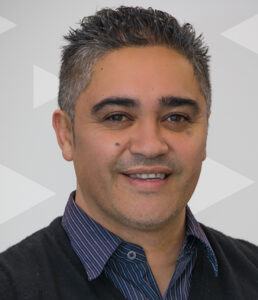
Raukotahi refers to coming and going which also has been the whakaaro of Pahia the son of Dame Tariana Turia. It is about our mahi, knowing who we are, who is coming behind us and after us whereever we are. We need to act accordingly as our tupuna would have acted. Recognising being Māori is about being able to express our values, confidence, and life long outcomes.
Aspects to one’s nature of being descendants of Maui. It’s about being steadfast and determined. We are multiple beings being Raukotahi – people coming and going. Our social structure is very inclusive. Therefore as caring nurses we have to do the right thing.
Anei te whakataukī o Whaea Putiputi O Brien (personal communication, July 28, 2009):
“Tomo mai ki te akoranga hauora, whakahokia ki te ao whānui”
“Enter to learn and go forth to serve”
References
- Scott (2006). Te Ōhanga Mataora Tapuhi Whakatauira Clinical Placement Framework. Providers of Te Ōhanga Mataora Bachelor of Sciences Māori (Nursing), Te Ngā Ngaru Hauora o Aotearoa, Te Kaunihera o ngā Neehi Māori o Aotearoa and Te Whare Wānanga o Awanuiārangi.
- Rika (2017). Te Raukotahi Model. The underlying principles guiding Te Ōhanga Mataora. [PowerPoint Slides] Kura Po Slide Share.
- Teepa (2020). Te Raukotahi model. The principles in nursing practice through the eyes of a Tauira.
- McGarvey (2021). Te Raukotahi Principles. Māori Nursing Advisory Ropu for Te Ōhanga Mataora Paetahi: Bachelor of Health Sciences Māori Nursing.
- Marshall (2023). Tangata Raukotahi [Power Point Slides] He Wānanga mō ngā Nēhi Māori ki Kokohinau Marae, Te Teko.
- Bristowe (2023). Tangata Raukotahi [Power Point Slides] He Wānanga mō ngā Nēhi Māori ki Kokohinau Marae, Te Teko.



